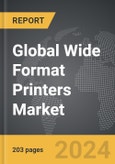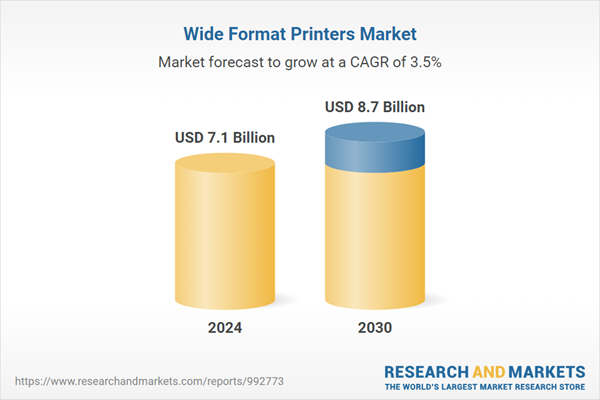Global Wide Format Printers Market - Key Trends and Drivers Summarized
Exploring the World of Wide Format Printers: Revolutionizing Visual Communication
Wide format printers are specialized devices designed to handle large print jobs, producing outputs that exceed the standard printing sizes. These printers are crucial in various industries such as advertising, architecture, engineering, and construction, where high-quality large-scale prints are essential. They are capable of printing on a wide range of materials, including paper, vinyl, fabric, and more, making them incredibly versatile. Wide format printers utilize advanced printing technologies, such as inkjet and laser, to deliver precise and vibrant prints. The process involves feeding large rolls of printing media through the machine, where the image or text is applied using fine nozzles or laser beams. This technology ensures high-resolution outputs, which are vital for detailed architectural blueprints, vibrant outdoor banners, and striking retail displays.Why Are Wide Format Printers Essential for Businesses?
In today’s visually-driven market, wide format printers play a pivotal role in enhancing brand visibility and communication. For businesses, these printers are indispensable tools for creating impactful marketing materials such as posters, banners, and billboards that grab attention and convey messages effectively. Architectural firms rely on them to produce detailed plans and renderings, ensuring precision and clarity in presentations and project planning. The ability to produce large-scale graphics and advertisements in-house offers businesses greater control over quality and timing, reducing dependency on external printing services and allowing for quicker turnaround times. Furthermore, wide format printers enable custom printing solutions, catering to the unique needs of different campaigns and projects. This flexibility not only helps in maintaining consistency in branding but also in adapting to market trends and consumer demands swiftly.How Are Innovations in Wide Format Printers Shaping the Industry?
Innovations in wide format printing technology are continuously pushing the boundaries of what these machines can achieve, significantly impacting the industry. The introduction of UV-curable inks and eco-solvent inks has improved the environmental footprint of printing processes, making them more sustainable without compromising on quality. Advances in print head technology, such as piezoelectric and thermal inkjet heads, have enhanced print speeds and resolution, enabling quicker production of high-quality prints. The integration of automation and IoT capabilities into wide format printers is streamlining operations, allowing for remote monitoring, maintenance, and automated workflows. This not only boosts efficiency but also reduces downtime and operational costs. Moreover, the development of hybrid printers, which can handle both rigid and flexible substrates, is expanding the applications of wide format printing, catering to diverse industry needs from packaging prototypes to interior decor.What Factors Are Driving the Growth of the Wide Format Printers Market?
The growth in the wide format printers market is driven by several factors reflecting technological advancements and evolving business needs. A significant driver is the increasing demand for high-quality, large-scale prints in advertising and branding, fueled by the need for eye-catching and effective visual communication. The expansion of the retail sector and the rise of digital signage are also contributing to market growth, as businesses seek innovative ways to attract and engage customers. Technological advancements, such as the development of more efficient and environmentally friendly inks, are making wide format printing more accessible and sustainable. The growing adoption of custom printing solutions in industries like interior design and fashion is further boosting demand, as these printers offer the flexibility to create unique, personalized products. Additionally, the integration of smart technology and automation in wide format printers is enhancing their functionality and ease of use, driving wider adoption across various sectors. These factors, combined with the continuous evolution of printing technology, are propelling the dynamic growth of the wide format printers market, ensuring its relevance and expansion in the digital age.Report Scope
The report analyzes the Wide Format Printers market, presented in terms of units. The analysis covers the key segments and geographic regions outlined below.Segments: Technology (Aqueous, Solvent, UV cured, Latex ink).
Geographic Regions/Countries: World; United States; Canada; Japan; China; Europe (France; Germany; Italy; United Kingdom; Spain; Russia; and Rest of Europe); Asia-Pacific (Australia; India; South Korea; and Rest of Asia-Pacific); Latin America (Argentina; Brazil; Mexico; and Rest of Latin America); Middle East (Iran; Israel; Saudi Arabia; United Arab Emirates; and Rest of Middle East); and Africa.
Key Insights:
- Market Growth: Understand the significant growth trajectory of the Aqueous segment, which is expected to reach US$3.8 Billion by 2030 with a CAGR of a 3.5%. The Solvent segment is also set to grow at 3.5% CAGR over the analysis period.
- Regional Analysis: Gain insights into the U.S. market, valued at $1.9 Billion in 2024, and China, forecasted to grow at an impressive 5.8% CAGR to reach $1.8 Billion by 2030. Discover growth trends in other key regions, including Japan, Canada, Germany, and the Asia-Pacific.
Why You Should Buy This Report:
- Detailed Market Analysis: Access a thorough analysis of the Global Wide Format Printers Market, covering all major geographic regions and market segments.
- Competitive Insights: Get an overview of the competitive landscape, including the market presence of major players across different geographies.
- Future Trends and Drivers: Understand the key trends and drivers shaping the future of the Global Wide Format Printers Market.
- Actionable Insights: Benefit from actionable insights that can help you identify new revenue opportunities and make strategic business decisions.
Key Questions Answered:
- How is the Global Wide Format Printers Market expected to evolve by 2030?
- What are the main drivers and restraints affecting the market?
- Which market segments will grow the most over the forecast period?
- How will market shares for different regions and segments change by 2030?
- Who are the leading players in the market, and what are their prospects?
Report Features:
- Comprehensive Market Data: Independent analysis of annual sales and market forecasts in US$ Million from 2024 to 2030.
- In-Depth Regional Analysis: Detailed insights into key markets, including the U.S., China, Japan, Canada, Europe, Asia-Pacific, Latin America, Middle East, and Africa.
- Company Profiles: Coverage of players such as Agfa-Gevaert N.V., Canon Inc., Electronics for Imaging Inc., HP, Inc., Konica Minolta Inc. and more.
- Complimentary Updates: Receive free report updates for one year to keep you informed of the latest market developments.
Some of the 62 companies featured in this Wide Format Printers market report include:
- Agfa-Gevaert N.V.
- Canon Inc.
- Electronics for Imaging Inc.
- HP, Inc.
- Konica Minolta Inc.
- Mimaki Engineering Co., Ltd.
- Océ-Technologies B.V.
- Ricoh Company, Ltd.
- Roland DG Corporation
- Seiko Epson Corporation
- Xerox Corporation
Tariff Impact Analysis: Key Insights for 2025
Global tariff negotiations across 180+ countries are reshaping supply chains, costs, and competitiveness. This report reflects the latest developments as of April 2025 and incorporates forward-looking insights into the market outlook.The analysts continuously track trade developments worldwide, drawing insights from leading global economists and over 200 industry and policy institutions, including think tanks, trade organizations, and national economic advisory bodies. This intelligence is integrated into forecasting models to provide timely, data-driven analysis of emerging risks and opportunities.
What’s Included in This Edition:
- Tariff-adjusted market forecasts by region and segment
- Analysis of cost and supply chain implications by sourcing and trade exposure
- Strategic insights into geographic shifts
Buyers receive a free July 2025 update with:
- Finalized tariff impacts and new trade agreement effects
- Updated projections reflecting global sourcing and cost shifts
- Expanded country-specific coverage across the industry
Table of Contents
Companies Mentioned (Partial List)
A selection of companies mentioned in this report includes, but is not limited to:
- Agfa-Gevaert N.V.
- Canon Inc.
- Electronics for Imaging Inc.
- HP, Inc.
- Konica Minolta Inc.
- Mimaki Engineering Co., Ltd.
- Océ-Technologies B.V.
- Ricoh Company, Ltd.
- Roland DG Corporation
- Seiko Epson Corporation
- Xerox Corporation
Table Information
| Report Attribute | Details |
|---|---|
| No. of Pages | 203 |
| Published | April 2025 |
| Forecast Period | 2024 - 2030 |
| Estimated Market Value ( USD | $ 7.1 Billion |
| Forecasted Market Value ( USD | $ 8.7 Billion |
| Compound Annual Growth Rate | 3.5% |
| Regions Covered | Global |









